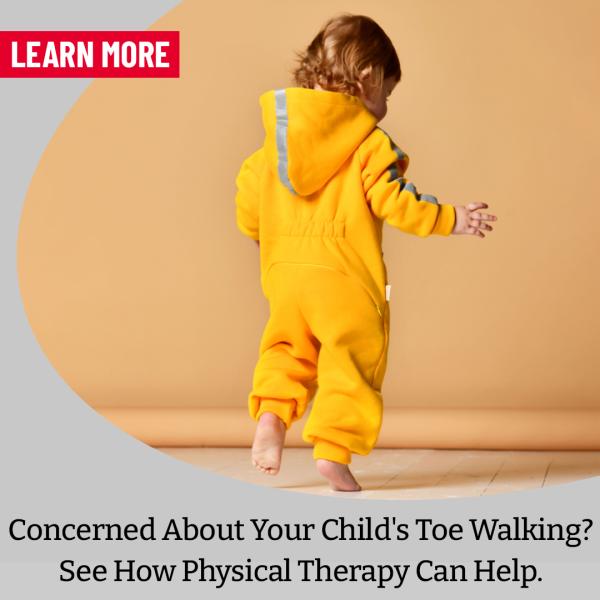
Reviewed and contributions made by Anne Kender, PT, DPT, c/NDT and Pediatric Physical Therapist
When a child learns to walk, instinctively, they will begin walking with their feet flat on the ground. As they practice, it’s not uncommon for them to move back and forth between toe walking and walking heel to toe. But if your child is still toe walking after the age of two, it’s recommended to talk to your pediatrician. They may then recommend seeing a physical therapist if toe walking persists.
Get Your Free Physical Therapy Screening
Want to discover how you or your child can benefit from physical therapy for toe walking? Get a free screening and let us help you start the path to recovery today.
GET MY COMPLIMENTARY SCREENING
Why do some children toe walk?
There are several reasons that children begin walking on their toes. Simply put, some children may feel more stable on their toes than walking heel to toe. If sensory reasons are the cause, the child may have difficulty tolerating pressure through their heels. They may also prefer the sensations they receive from their joints locking out. Another reason a child may walk on their toes is due to a lack of range of motion in their calf muscles (gastrocs).
When to see a specialist
As your child’s coordination and muscles develop, they will begin walking with a flat foot/mid-foot contact. On average, this starts around 18 months of age. According to our pediatric physical therapist, Anne Kender: “If your child still walks on their toes beyond age 2-3, it's recommended that you talk to your pediatrician.” While many children outgrow this condition, toe walking can be a sign of a neurological disorder, like cerebral palsy.
What are the long-term effects of toe walking?
As you can imagine, toe walking places a great load on the muscles and tendons. Many children who walk on their tiptoes once they become independent may develop foot deformities. This may occur as early as the age of four. These children may demonstrate:
- Ankle range of motion restrictions
- Impaired balance
- Poor postural alignment
If left untreated, toe walking can put your child at further risk for contractures (i.e., shortened muscles), foot deformities and balance issues. In severe cases, your child may need surgical interventions if deformities or contractures are present. Fortunately, physical therapy interventions are often an effective way to help your child.
Physical therapy for toe walking
Physical therapy for toe walking can assist your child in achieving a heel-toe walking pattern. It may also correct any range of motion restrictions, muscle imbalances and postural deformities.
Upon your first visit, your physical therapist will identify the child's origin for toe-walking. Once the source of the issue is identified, the therapist will determine a care plan.
Treatment methods typically include:
- Stretching
- Strengthening of lower extremities and core
- Balance retraining
- Sensory integration techniques
- Serial casting
- Orthotic training
- Home exercise program
After you finish physical therapy for toe walking, what’s next?
Once your child has successfully completed their PT treatment, you will receive a home exercise program. For children with an established heel-to-toe pattern their home program will be minimal. That is, if they no longer demonstrate weakness or range of motion restrictions.
For children with neurological conditions, they may require intermittent services throughout their lifetime. This additional therapy will help them maintain gains, especially around growth spurts.
Is your child toe walking? ATI may be able to help.
If you are concerned about your child walking on their toes, we first suggest talking with your pediatrician. They will help you determine the next course of action. Should physical therapy be required, don’t hesitate to contact your nearest ATI physical therapy clinic. Our therapists will work with you to see what pediatric therapy options are available for your child.
